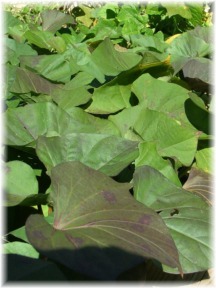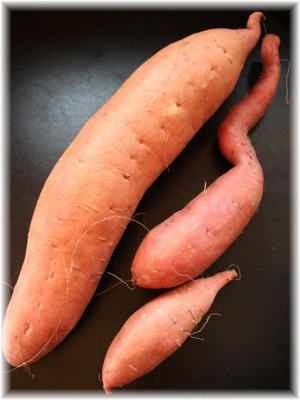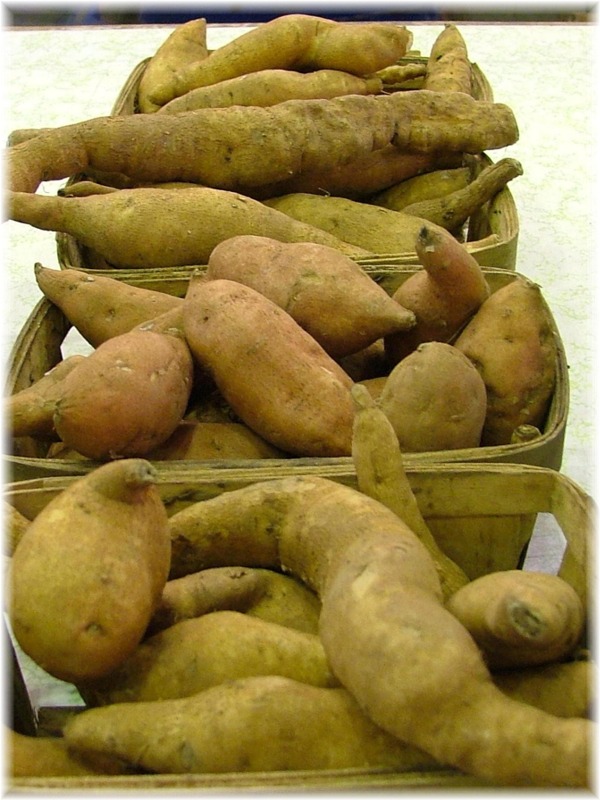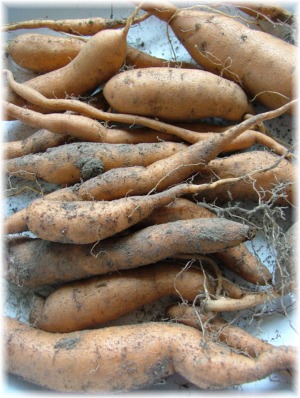|
|
|
|
|
|
|
|
John Scheepers Kitchen
Garden Seeds
Tips
for Harvesting and Storing Sweetpotatoes
Thank you for having signed up
for horticultural emails from Kitchen
Garden Seeds, Van Engelen and John Scheepers.*
We enjoyed its attractive, lavish foliage all summer long. Now, as fall nights cool down and days get shorter, it is almost time to get at the sunken treasure~our long awaited, luscious, sugary Sweetpotatoes.
Sweetpotatoes may look a lot like regular white potatoes, but the two are completely unrelated and the way you grow, cure and store them is completely different. If you provide warm soil and a long growing season, sweet potato plants can be amazingly productive—as much as 10 lbs. from a single plant. An abundant harvest means happy days ahead: velvety-smooth soups and heavenly roasted mélanges, hearty enchiladas and bubbly casseroles, moist and flavorful cakes, muffins and scones. With a little extra attention at harvest time, you can be eating homegrown Sweetpotatoes almost every month of the year.
When to Harvest
Sweetpotatoes
Sweetpotatoes
may be dug in early fall as soon as the tubers reach a good size. But
don’t hurry. The longer Sweetpotatoes stay in the ground, the larger and
sweeter they get. Even an extra week can make a difference, so it’s best
to wait until the leaves start to yellow or frosty weather is approaching.
(Should the vines get frosted, it’s important to harvest immediately to
prevent the decay from moving down into the tubers.)
Sweetpotatoes form right at the base of the plant, just barely under the ground. If the soil is relatively loose, you can simply brush it away to reveal the tubers. If your soil is heavier, use a garden fork to dig down and loosen the soil, then lift the plant and tubers up out of the ground. If you grew your Sweetpotatoes in a fabric bag or another type of pot, simply turn the pot over on a tarp and allow the soil, and Sweetpotatoes, to tumble out.
When a Sweetpotato first comes out of the ground, its skin is very thin and it can be easily nicked or bruised. Handle the tubers as gently as eggs, transferring them carefully to a bin that’s been lined with burlap or an old blanket. Move the potatoes out of the sun into a warm, dry location and lay them out in a single layer, so the skins can dry for a week or so.
How to Cure Sweetpotatoes
If you plan to use up your Sweetpotato
harvest within a month or two, it isn’t necessary to “cure”
them. Simply air-dry the tubers for 7 to 10 days at 75 to 80 degrees F. For
long-term storage, Sweetpotatoes should be cured at 90 degrees F and 85%
humidity for 5 to 7 days. Home gardeners with a modest-sized harvest can do
this quite easily in a regular oven. You will need a portable oven thermometer,
a 9 x 13 pan of water, a 40 watt light bulb and a light bulb socket on a cord.
Put the thermometer on a middle rack, close the door almost all the way (use
something thin like a metal spatula to keep the door just slightly ajar) and
check the temperature after about 10 minutes. This is your starting point.
Now, screw the light bulb into the socket, place the bulb on a rack inside the oven, run the cord out the door and plug it in. The cord will now serve to keep the door open just the right amount. After an hour, check the temperature. You may need to open the door a little wider or change the bulb wattage to achieve exactly 90 degrees. Once you have the temperature right, load the Sweetpotatoes onto the oven racks so they’re not touching. Position the light bulb so it is at least 6 inches away from the nearest tuber and put the pan of water in the bottom of the oven. Close the door (it should be just slightly ajar) and begin the 5-day curing period (6 or 7 days is OK, but don’t make it less than 5). A piece of masking tape over the oven dial will ensure no one accidently turns the oven on during the curing period.
Storing Sweetpotatoes
Once your Sweetpotatoes have
been air-dried or cured, nestle them into a box or wooden crate, allowing
plenty of room for good air circulation. Regular Potatoes
should be stored cold (45 degrees F) and moist (95% humidity), but
Sweetpotatoes must be stored under warmer and less humid conditions. An air
temperature of 55 to 60 degrees F is perfect, with a humidity level of 75% to
80%. A cool, dry basement usually works fine.
Our affection for Sweetpotatoes grew when we learned they are almost twice as nutritious as any other vegetable. High in vitamin C as well as calcium, folate, potassium and beta-carotene (which the body converts to vitamin A), Sweetpotatoes are also an excellent source of dietary fiber, protein and iron. And, though they are sweet, Sweetpotatoes have half the glycemic load of white potatoes. They are a good carb that our bodies digest slowly, so we feel satisfied far longer than with most other foods.
There are so many delicious ways to enjoy these delicious, incredibly versatile kitchen chameleons: baked (in the skin like a russet potato), parboiled or steamed, grilled, oven-fried (tossed with olive oil and baked on a cookie sheet) or roasted (with Beets, Onions, Garlic and Carrots). Sweetpotatoes are garden gold, and we look forward to eating them all winter long.
We share our best-of-the-best recipes so you can feed your family and friends well without feeling frenzied, and practical, hands-on horticultural tips to demystify gardening with seeds (it need not be tricky or difficult. Truth be told, it is a bit more like easy magic.) If you need help with anything, our office hours are Monday through Friday from 9:00 a.m. to 5:00 p.m. You can email us at customerservice@kitchengardenseeds.com or call us at (860) 567-6086. Lance Frazon, our seed specialist, is happy to help you in any way possible. He loves to talk seeds.
-To see our seed collection click: Flowers, gourmet fruits & vegetables and aromatic herbs.
-To request a 2013 Kitchen Garden Seeds catalog, click: Request catalog.
-To look at our yummy recipes, like Roasted Sweetpotato Coins, click: Recipes.
-Or, call us at (860) 567-6086: we will help you in any way we can!
*We never rent or borrow email addresses from anywhere. In the course of requesting one of our bulb or seed catalogs, you provided us with your email address. If you prefer to not receive any emails from us, please know that we honor all unsubscribe requests.
John Scheepers Kitchen Garden Seeds
23 Tulip Drive * PO Box
638 * Bantam, CT 06750
Phone: (860) 567-6086 * Fax: (860) 567-5323
To unsubscribe/change profile: click
here
To see on-line version of this email: click
here
To subscribe: click here
© 2001-2013 John Scheepers Kitchen Garden Seeds. All rights reserved.



